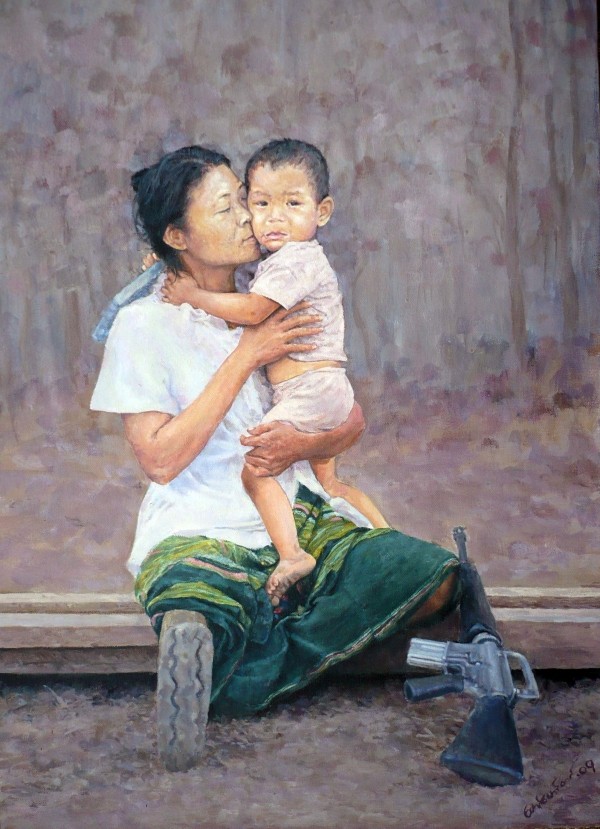On The Border: A Story of Forced Migration From Burma
Mestizo Arts showcases art inspired by refugees from Burmese genocide.
By Brian Staker @stakerizedArt is capable of a lot of things—including fulfilling a role of visual storytelling, of cultural expression, and serving as vehicle for political awareness. Mestizo Coffeehouse & Art Gallery, a multicultural touchstone in Salt Lake City, is exhibiting On the Border: A Story of Forced Migration from Burma, which features the watercolors of Maung Maung Tinn, a Burmese artist living near the border of Burma and Thailand, whose works depict the struggles of refugees fleeing torture and genocide by the Burmese military regime.
“Karen people are one of the eight indigenous groups in Burma being tortured and killed by the Burmese military regime,” notes Ler Wah of the Karen Community of Utah. As a result of the genocide, Karen fled to Thailand and settled in refugee camps along the Thai-Burma border. Many have lived there for 20 years or more, disconnected from the outside world for all those years; resources such as food, health care, education, employment and media have been limited.
“Some of them resettled to [the] United States to start their new lives, but still, there are barriers such as language, transportation, access to public resources and familiarity with technological devices, such as phones,” Wah says.
Tinn has a very interesting attitude about the uses of art: “Media is very important to show situations to people. Art is one part of [the] media.” Oftentimes he paints from photographs, such as the poignant image of a mother holding a child, a rifle at her knee for protection (pictured).
“I choose the photo [to paint] that can represent the situation of our lives, how we are suffering,” Tinn says. “My painting cannot tell everything. But something.”
“The art depicts the daily lives of the Karen people living at the border of Thailand and Burma, as well as in Burma,” observes Trinh Mai, associate professor of social work at the University of Utah. “They show families journeying to find safety, families seeking refuge from violence by living in a landfill, children at home in refugee camps. The paintings also show the strength, resilience and joy in people’s faces.”
The condition of life as a refugee is all too common across the globe, explains Rosemarie Hunter, special assistant to the president for Campus Community Partnerships at the University of Utah and director of University Neighborhood Partners, which helped coordinate the exhibit, along with the local Karen community and University of Utah faculty and students.
“The art also depicts the journey and the history of the people of Burma now living in Salt Lake City and many cities across the world,” Hunter says. “Many communities of refugee and immigrant backgrounds share similar histories, and have impressed upon us the importance of telling their stories and of not forgetting the 10.3 million people around the world who continue to live in protracted refugee situations.”
For Mai, Mestizo was an obvious choice to host the show. “We chose Mestizo because it is a gallery that is committed to promoting art, community and social justice. These themes are important to this art exhibit and its creators.”
The exhibit is also an educational opportunity about a situation of which not many Americans are aware, says Yda Smith, director of graduate studies for the department of occupational therapy at the University of Utah. “The Karen people, along with other ethnic minorities in Burma, have been fighting against the Burmese military government to maintain their land and their ethnic traditions since the end of World War II,” Smith says. “They have suffered, and continue to suffer, from persecution, and the physical harm caused by landmines and other war atrocities. The Karen living in the refugee camps and those living as undocumented migrants in Thailand face an uncertain future and are trapped in a situation that makes it impossible to fulfill their aspirations for a good life in a peaceful community. This exhibit provides a glimpse of the reality of what is happening on the Thai-Burma border today.”
The exhibit is a fundraiser for the refugees living on the border and the local Karen community, and for a member of the Karen community to travel with a university group doing humanitarian/education work at the border. The opening included a Karen weaving demonstration and sale. Donations can be made to University Neighborhood Partners (1060 S. 900 West, Salt Lake City, 84104). To purchase weaving products, contact yda.smith@hsc.utah.edu.
The conditions at the border persist, but in the meantime, Tinn perseveres. “I still paint and write. Because the situation of my home, my country, has not really changed yet. I do hope my painting can tell something.”
ON THE BORDER: A STORY OF FORCED MIGRATION FROM BURMA
Mestizo Coffeehouse & Art Gallery
641 W. North Temple, Suite 700
Through Jan. 11
Free
MestizoArts.server295.com
More by Brian Staker
-
Live Music Picks: April 12-18
Judas Priest, The Residents, Clownvis Presley, The Breeders and more.
- Apr 11, 2018
-
Loving the Alienation
Helios Creed and Chrome continue making iconoclastic music for outcasts.
- Mar 28, 2018
-
Live Music Picks: March 22-28
U.S. Girls, Ed Schrader’s Music Beat, Hell’s Belles, Columbia Jones and more.
- Mar 21, 2018
- More »



